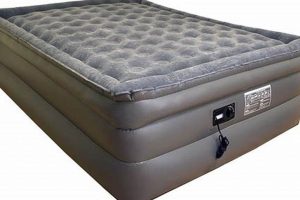The standard dimensions of a full mattress, often referred to as a double mattress, are approximately 54 inches in width and 75 inches in length. These measurements are crucial when determining the compatibility of bedding accessories, such as sheets and bed frames. For example, fitted sheets designated as “full size” are designed to accommodate these specific dimensions.
Understanding these dimensions is important for space planning within a bedroom. A full mattress offers more width than a twin mattress, which can be beneficial for individuals who desire additional sleeping space. Historically, the “full” size mattress provided a larger alternative to the single bed, accommodating growing needs without occupying excessive floor area.
The subsequent discussion will delve into specific considerations when selecting a mattress, factors influencing the accuracy of reported sizes, and common misconceptions regarding mattress dimensions. Furthermore, advice on how to measure existing bed frames to ensure proper fit will be presented.
Essential Considerations Regarding Full Mattress Dimensions
Accurate understanding of full mattress dimensions is critical for optimal comfort and compatibility. The following tips address key areas to consider when working with these dimensions.
Tip 1: Verify Measurements Prior to Purchase: Always confirm the stated mattress dimensions with the retailer. Slight variations can occur due to manufacturing tolerances, potentially affecting fit within existing bed frames.
Tip 2: Account for Bedding Bulk: When calculating space requirements, consider the additional space occupied by bedding, such as thick comforters or mattress toppers. This prevents overcrowding in smaller rooms.
Tip 3: Measure Bed Frames Internally: Do not rely solely on the labeled bed frame size. Measure the interior dimensions of the frame to ensure the mattress fits snugly and securely within the support structure.
Tip 4: Understand International Variations: If sourcing mattresses or bedding from outside the domestic market, be aware that dimensional standards may differ. Convert measurements to ensure compatibility.
Tip 5: Consider Weight Distribution: Full mattresses are typically designed to support the weight of one to two adults. Exceeding the weight capacity can lead to premature wear and tear and compromise support.
Tip 6: Recognize Standard Sheet Sizes: Confirm that any sheets or covers purchased are specifically labelled as ‘full’ size. Other sizes may not be a proper fit which can cause issues for the user of the mattress.
These considerations underscore the need for precise dimension awareness when selecting a full mattress. Attention to detail at this stage contributes to long-term satisfaction and optimal sleep quality.
The final section of this article presents resources for further information on mattress selection and care.
1. Width
The dimension of 54 inches for mattress width is a critical element defining the “full size mattress measurements inches” category. This measurement dictates the space available for individual occupants and influences considerations related to bedding, frame selection, and overall room design.
- Occupancy Comfort Level
The 54-inch width accommodates one adult sleeper comfortably or two adults in close proximity. While offering more width than a twin mattress (approximately 39 inches), it provides less individual space compared to queen (approximately 60 inches) or king (approximately 76 inches) mattresses. The selection hinges on individual preferences for space and comfort.
- Bedding Compatibility Implications
The specific width necessitates the use of bedding products labeled as “full” or “double” size. Fitted sheets, flat sheets, and comforters designed for other mattress sizes are incompatible. Ensuring bedding matches the 54-inch width is essential for proper fit and aesthetic presentation.
- Frame Dimensions and Support Structures
Bed frames intended to support a full size mattress must be dimensionally compatible with the 54-inch width. Insufficient frame support can lead to mattress sagging or damage over time. Accurately measuring the interior dimensions of a prospective bed frame is crucial to ensure proper mattress fit and long-term support.
- Room Space Planning Constraints
The 54-inch width contributes to the overall footprint of the full mattress, influencing room layout and traffic flow. In smaller rooms, this width may limit space for additional furniture. Careful consideration of room dimensions relative to the mattress width is paramount for creating a functional and aesthetically pleasing environment.
Therefore, the 54-inch width measurement is not merely a numerical value but a fundamental factor governing the functionality, comfort, and spatial integration of a full size mattress. Its implications span bedding selection, frame compatibility, occupant comfort, and room planning, underscoring its integral role in the overall mattress experience.
2. Length
The 75-inch dimension represents the length component of a full size mattress. This measurement, when considered alongside the 54-inch width, defines the total sleeping surface area. Understanding its implications is crucial for occupant comfort and compatibility with associated bedroom furnishings.
- Occupant Height Accommodation
The 75-inch length is generally suited for individuals up to approximately 5 feet 10 inches in height. Taller individuals may experience restricted legroom and discomfort during sleep. Selecting a mattress that adequately accommodates the sleeper’s height is essential for promoting restful sleep and preventing physical strain.
- Bed Frame Compatibility Mandates
Bed frames designated for full size mattresses are designed to accommodate the 75-inch length. Discrepancies between the mattress length and the frame dimensions may result in improper mattress support and potential structural instability. Precise measurement of the interior frame dimensions is therefore imperative.
- Bedding Size Synchronization
Sheets, comforters, and other bedding accessories intended for use with a full size mattress must be sized accordingly. Bedding designed for shorter mattresses will not adequately cover the sleeping surface, while excessively long bedding may present aesthetic or functional drawbacks. Proper size synchronization between mattress length and bedding dimensions is crucial for both comfort and visual appeal.
- Spatial Footprint Considerations
The 75-inch length contributes significantly to the overall footprint of the full size mattress. This dimension must be carefully considered when planning room layouts, particularly in smaller spaces. Insufficient space around the bed can impede movement and create a sense of confinement. Effective room planning integrates the mattress length into the overall spatial design to optimize functionality and comfort.
In conclusion, the 75-inch length measurement is an indispensable element of the full size mattress profile. Its interplay with occupant height, bed frame compatibility, bedding size synchronization, and spatial considerations underscore its critical importance in achieving optimal sleeping comfort and overall bedroom functionality. The precise relationship between this dimension and these contributing factors validates its essential role in understanding the full size mattress measurements inches concept.
3. Surface Area
Surface area, derived directly from full size mattress measurements inches, dictates the available space for a sleeper. The standard dimensions of 54 inches in width and 75 inches in length yield a total surface area of 4,050 square inches. This calculation is not merely academic; it represents the tangible space within which a person rests and moves during sleep. For example, an individual accustomed to a twin mattress, with its smaller surface area, might find the additional space of a full mattress beneficial for enhanced comfort and freedom of movement. Conversely, those accustomed to a larger mattress, such as a queen or king, could experience a feeling of confinement on a full size mattress due to its reduced surface area. Therefore, an understanding of surface area as a function of dimensions directly informs the suitability of the mattress for individual needs.
The practical implications extend beyond individual comfort. The surface area dictates the type and size of bedding required. Fitted sheets, blankets, and mattress protectors must be designed to accommodate the specific dimensions to ensure proper fit and functionality. Purchasing bedding without considering the mattress surface area results in ill-fitting linens, compromising both comfort and aesthetics. Furthermore, surface area considerations influence the weight distribution and support characteristics of the mattress. A larger surface area, combined with appropriate internal construction, can better distribute body weight, reducing pressure points and promoting spinal alignment. However, if the support structure is inadequate for the given surface area and weight load, premature sagging or deformation may occur.
In summary, the surface area derived from “full size mattress measurements inches” is a critical determinant of comfort, bedding compatibility, and mattress performance. While width and length represent individual dimensions, the resulting surface area encapsulates the overall sleeping space and its implications. A thorough understanding of this derived value enables informed decision-making when selecting a mattress and associated bedding, leading to enhanced sleep quality and long-term satisfaction. Overlooking the surface area risks compromising both comfort and the longevity of the sleep system.
4. Frame Compatibility
Frame compatibility is intrinsically linked to the standardized dimensions of a full size mattress. The established “full size mattress measurements inches” serve as the foundational parameters for bed frame design. A mismatch between these dimensions leads to inadequate mattress support, premature wear, and potential safety hazards. The standardized width of 54 inches and length of 75 inches dictate the interior dimensions required of a compatible bed frame. Any deviation from these measurements compromises the structural integrity of the sleep system. For instance, a frame too large for a full mattress leaves unsupported gaps, leading to mattress sagging. Conversely, a frame too small causes the mattress to buckle, diminishing its comfort and lifespan.
The ramifications of incompatible frame dimensions extend beyond mattress degradation. Insufficient support impacts weight distribution, potentially causing uneven compression of the mattress layers. This unevenness can lead to pressure points, disrupting sleep and exacerbating musculoskeletal issues. Furthermore, an improperly supported mattress is more susceptible to damage from routine use. Repeated stress on unsupported areas accelerates wear and tear, shortening the mattress’s effective lifespan. Bed frame design also incorporates support elements, such as slats or a solid foundation, that complement the mattress’s internal structure. An incompatible frame may lack these elements, further compromising support and voiding mattress warranties.
In summary, frame compatibility is not a peripheral consideration but an integral component of a functional sleep system. The standardized “full size mattress measurements inches” define the dimensional requirements for compatible bed frames. Adhering to these standards ensures adequate mattress support, extends its lifespan, and promotes optimal sleep quality. Failure to consider frame compatibility introduces risks ranging from discomfort to safety hazards, underscoring the necessity of meticulous attention to dimensional specifications.
5. Bedding Needs
The relationship between bedding needs and full size mattress measurements inches is a direct and unavoidable consequence of standardized sizing. The industry-established dimensions of approximately 54 inches in width and 75 inches in length dictate the precise size of sheets, blankets, comforters, and mattress protectors required for adequate coverage and functionality. Incorrectly sized bedding creates practical problems, such as sheets that do not properly fit the mattress corners, blankets that are too short to adequately cover the sleeper, or mattress protectors that bunch and fail to provide full protection. For example, attempting to use twin-sized sheets on a full mattress results in inadequate coverage and compromised comfort, defeating the purpose of using sheets. Bedding needs are therefore not arbitrary preferences but rather dimensional imperatives directly derived from the mattress size.
The accurate selection of bedding based on full size mattress measurements inches has significant implications for hygiene, comfort, and the longevity of the mattress. Fitted sheets that fit snugly prevent the accumulation of dust mites and allergens within the mattress fibers. Properly sized blankets and comforters ensure adequate thermal regulation during sleep, promoting a comfortable sleep environment. A mattress protector designed for a full size mattress guards against spills, stains, and other forms of damage, extending the mattress’s lifespan. The financial and practical consequences of using ill-fitting bedding range from increased allergen exposure and discomfort to premature mattress degradation and the need for costly replacements. The bedding, therefore, acts as a functional extension of the mattress, dependent on correctly specifying its dimensions to align with the mattress size.
In conclusion, recognizing the inextricable link between bedding needs and full size mattress measurements inches is paramount for ensuring optimal sleep hygiene, comfort, and mattress protection. The standardized dimensions provide a clear and unambiguous framework for selecting appropriately sized bedding, mitigating the risks associated with mismatched components. The understanding of this connection enables informed purchasing decisions, ultimately contributing to a more restful and hygienic sleep experience. The adherence to dimensional standards in bedding selection is, therefore, a practical necessity derived directly from the dimensions of the mattress itself.
6. Room Dimensions
The consideration of room dimensions in relation to a full size mattress is a crucial aspect of interior design and space planning. A comprehensive understanding of how “full size mattress measurements inches” interact with the overall room size contributes to both the functionality and aesthetics of the bedroom.
- Minimum Room Size Requirements
A room intended to accommodate a full size mattress requires minimum dimensions to ensure adequate space for movement and additional furniture. While specific dimensions vary based on individual needs and room layout, a general guideline suggests a minimum room size of approximately 10 feet by 10 feet. This allows for the inclusion of the mattress and basic furnishings without overcrowding.
- Traffic Flow Considerations
The dimensions of a full size mattress directly impact traffic flow within a bedroom. Adequate space must be maintained around the bed to allow for unimpeded movement and access to other areas of the room, such as closets or windows. Insufficient space can lead to awkward navigation and a sense of confinement. Therefore, the placement of the mattress must be carefully considered in relation to doorways and walkways.
- Furniture Placement Implications
The size of a full mattress influences the placement of other furniture pieces within the room. Nightstands, dressers, and chairs must be strategically positioned to maximize space and functionality. Overcrowding the room with excessive furniture detracts from the overall comfort and aesthetics of the space. Therefore, the selection and arrangement of furniture must be carefully coordinated with the dimensions of the mattress and the overall room size.
- Aesthetic Harmony and Balance
The visual impact of a full size mattress within a room is influenced by the relationship between the mattress dimensions and the overall room proportions. A small room dominated by a large mattress can feel cramped and unbalanced. Conversely, a full size mattress in an expansive room may appear disproportionately small. Achieving aesthetic harmony requires careful consideration of scale and proportion, ensuring that the mattress complements the overall room design.
In conclusion, the interaction between room dimensions and the specific “full size mattress measurements inches” is a fundamental consideration in bedroom design. The effective management of space, traffic flow, furniture placement, and aesthetic balance hinges on a thorough understanding of the dimensional relationship between the mattress and the room. A well-planned layout ensures both functionality and visual appeal, creating a comfortable and harmonious living space.
7. Weight Considerations
Weight considerations represent a critical, yet often overlooked, dimension within the broader scope of “full size mattress measurements inches.” While the literal inches define the surface area, weight limits imposed by mattress construction directly influence its performance, durability, and suitability for specific users. Exceeding the manufacturer’s specified weight capacity, even within the physical boundaries of the 54-inch by 75-inch dimensions, compromises the structural integrity of the mattress. For instance, a couple with a combined weight significantly exceeding the mattress’s designed limit will experience premature sagging, reduced support, and potential damage to internal components. The practical result is diminished sleep quality and a shortened lifespan for the mattress, despite its seemingly appropriate physical size.
The interplay between weight capacity and dimensions extends to the selection of appropriate bedding and support structures. A full size mattress, regardless of its dimensions, requires a bed frame capable of bearing the combined weight of the mattress and its occupants. Insufficient support from the frame exacerbates the effects of exceeding weight limits, accelerating mattress degradation. Moreover, the choice of bedding materials, such as thick mattress toppers, can add to the overall weight load. For example, a memory foam topper, while enhancing comfort, also increases the demand on the mattress’s support system. Careful attention to the weight characteristics of all components is essential for maintaining the long-term performance of a full size mattress, despite its “full size mattress measurements inches”.
In summary, weight considerations are an implicit, yet vital, component of understanding “full size mattress measurements inches.” The standardized dimensions provide the physical parameters, but the mattress’s capacity to support weight dictates its true usability and longevity. Recognizing this relationship is crucial for informed mattress selection, ensuring both comfort and durability over time. Failure to account for weight limits, despite adhering to dimensional standards, leads to compromised sleep quality and reduced mattress lifespan. Therefore, weight consideration should be considered an important factor in full size mattress.
Frequently Asked Questions
This section addresses common queries related to the dimensions of full size mattresses, providing clarity and dispelling potential misconceptions.
Question 1: What are the exact dimensions defining a full size mattress?
The industry standard for a full size mattress is approximately 54 inches in width and 75 inches in length. Minor variations may exist due to manufacturing tolerances, but these measurements serve as the accepted norm.
Question 2: How do full size mattress measurements inches compare to those of a queen size mattress?
A queen size mattress is wider and longer than a full size mattress. While a full is 54 x 75 inches, a queen measures approximately 60 inches in width and 80 inches in length, offering significantly more sleeping space.
Question 3: Are “full” and “double” size mattresses dimensionally identical?
Yes, the terms “full” and “double” are used interchangeably to describe mattresses with dimensions of approximately 54 inches by 75 inches.
Question 4: Can standard full size sheets be used on mattresses with slightly different thickness measurements?
While the width and length are critical, sheet sets often accommodate mattresses of varying thicknesses due to elasticized edges or deep pockets. However, significant discrepancies in mattress thickness may require specialized sheets.
Question 5: How do full size mattress measurements inches impact room size planning?
The mattress dimensions are a primary consideration in determining the minimum room size. Adequate space must be allocated for movement and additional furniture, ensuring a functional and aesthetically pleasing environment.
Question 6: Are there international variations in full size mattress measurements inches?
While the 54 x 75 inches dimensions are widely accepted, slight regional variations may exist. When purchasing mattresses or bedding from international sources, verifying the specific measurements is advisable.
Accurate understanding of full size mattress dimensions is essential for informed purchasing decisions and optimal sleep quality.
The next section will focus on Resources and Further Research.
Conclusion
This exposition has thoroughly examined the significance of “full size mattress measurements inches.” The standardized dimensions of approximately 54 inches by 75 inches dictate compatibility with bedding and bed frames, influence room layout, and inform weight distribution considerations. A precise understanding of these dimensions is not merely a matter of preference but a prerequisite for optimal sleep quality and long-term mattress performance.
In conclusion, a comprehensive grasp of “full size mattress measurements inches” empowers individuals to make informed decisions, ensuring a functional and comfortable sleep environment. The inherent link between these dimensions and factors such as frame support, bedding fit, and room space underscores their enduring importance in the realm of bedding selection.







